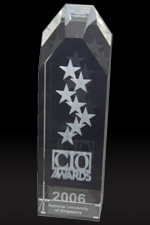Grid System wins CIO Award 2006: A spirit of sharing
2006
Emerged from among 100 nominations from the private and public sectors, Computer Centre Director, Tommy Hor received the top CIO Award 2006 on 7 April, 2006 at the Grand Hyatt Hotel. The Computer Centre’s Tera-scale Campus Grid, TCG@NUS, is one out of just five recipients of the CIO Award 2006.
It is a true spirit of sharing with no boundary
– Tommy Hor
Article from Digital Life – 6 June 06
PUTTING IDLE PC TIME TO BRAINIER USE
A network of 1,300 computers at the National University of Singapore, otherwise idle at night or lunch, is pooled together to allow millions of searches to be done at once with no stalling of systems needs by Serene Luo
Each time Associate Professor Tan Tin Wee set his biochemistry students on a project, chances were he and his students would get banned from the websites or other public access resources.
This is because they generated “waves of 300 clicks on their webpages at one time with exactly the same query”.
But those were the days before the National University of Singapore (NUS) put together its own large personal computer grid – a network of computers that have the brainpower of a supercomputer, but at a fraction of the cost.
Called the Tera-Scale Campus Grid or TCG@NUS, this grid network is believed to be the largest one among education institutions in South-east Asia, having 1,300 computers linked together to-date.
At its peak, the network can deliver the computing power of four TFLOPS or Trillions of Floating-point Operations per Second.
Computers that are being used for word processing or Internet surfing, or those that are idling at night or during lunchtime, usually do not use their entire computing capacity.
In grid computing, this excess “brainpower” is directed and harnessed to “help” other applications that need more computing muscle.
What it means is that research work that involves a great number of calculations, such as in climate modelling, for example, can be completed much faster – in seconds or minutes, instead of days and weeks.
Supercomputer at work
According to Prof Ng Kah Hwa from the Science Faculty, a set of 300,000 simulations runs in one of his research calculations used to make his personal computer come to a total standstill.
“It would just hang there,” he explained, describing how he could not do any other kind of work, not even check his e-mail.
But now with the support of the TCG@NUS, the results come out in just 100 seconds.
Even if he ups the number of stimulations by 1,000 times to 3 million simulations, “the grid still comfortably finishes computing in minutes”, Prof Ng said.
And the faster compute time means PhD students like Bernett Lee can maintain his database of gene splicing analytics more up-to-date than before.
Mr Lee said: “By bringing the computation down to days, I can keep my database up to date weekly (instead of monthly).
“Grid computing will help me maintain the reputation of our internationally accessible database.”
Linking 3,000 computers
The best part was, the university “got a lot of resources overnight”, said Mr Tommy Hor, the director of the NUS Computer Centre, which is spearheading this project.
With a $300,000 investment in software, the university gained computing power, which would have cost $3 million to $4 million, if it had bought dedicated supercomputing machines instead.
Of course, supercomputers would be able to do computations that require sequential calculations – those that need one result before being able to calculate another – while grids are only able to do calculations in parallel – where the job can be split into many parts and done in many different places.
The hardest part was probably convincing the various faculties and departments to pitch in and “lend” their computers to hook up to the grid, said Mr Hor.
“They were concerned about whether their own data would be compromised since they were sharing computers. Or if their own jobs would be slowed down by other peoples’,” he said.
To squelch their fears, they installed security applications to make sure only authorised computing jobs were accepted and that they were “clean”.
Also, there was a function that allowed users to give priority to their own jobs, even selecting when they wanted to share computing power and when they did not.
The next step is to convince more NUS users to “donate” their computers to the effort, and to link up some 3,000 computers to their TCG@NUS by the middle of next year.
This is three times the size of the National Grid, which the National Grid Office now runs.
“We are a research institution,” said Mr Hor. “The grid will enable more kinds of research, at a faster rate.”


